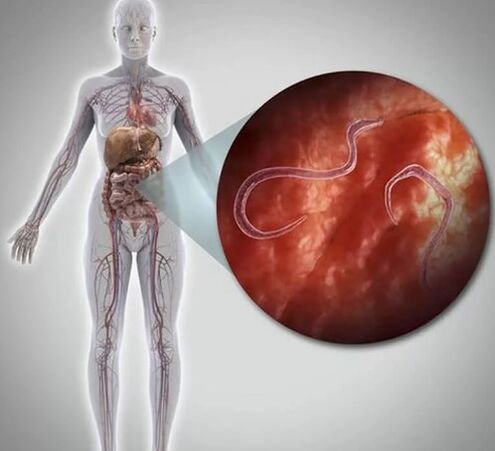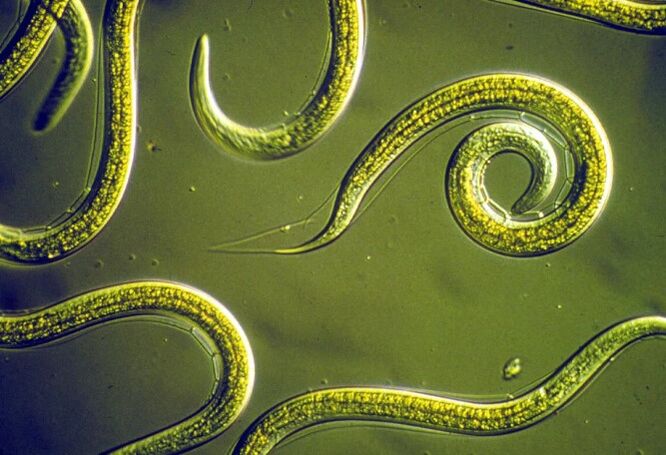Human parasites are parasites whose infections are affected by a person. The general definition of the term "parasitic" applies not only to multicellular and protozoa at the expense of the owner and the damage of the latter, but also to the damage of the latter, and to viruses, bacteria and mushrooms of similar qualities. According to historical traditions, from the perspective of medical parasitology, except for viruses and bacteria with similar qualities, they are customarily called any organism leading the parasitic lifestyle.

Parasites include many worms, fungi, viruses, protozoa, worms, crustaceans, spider-shaped, insects. The owner of the parasite can be bacteria, simplest, plants, animals and humans. Parasites go through a complex cycle of development: Sometimes they need to change 2-3 owners whose bodies are intermediates (worms pass through the larval stage) or eventually (worms become invasive).
From history:
The research on ancient parasites is based on the study of feces and other petrochemical materials. The earliest parasite found in humans is the Paragon Westmani egg from northern Chile, found in hardened feces, dating about 5900 B. C. e. In Brazil, hookworm eggs from 5000 BC were also found. For example, in Peru-Nematod eggs in 2330 BC. e. There are also Egyptian mummies that date back to 2000, 1250 and 1000 years. B. C. e. They together with a well-preserved female worm contain a solvent egg.
In Berlin, 1866-1875. Of all open carcasses, 16% contain worms. Bull Taperly (Taeniarynchus Saginatus) is particularly extensive in places where you eat raw beef. According to Kessler, in St. Petersburg, 3. 66% of the people he was surveyed had this parasite (1888). Pork nachos (Taenia solium) are everywhere in areas where they eat raw or semi-pulp pork. In St. Petersburg, about 3% of the population suffered from this parasite in the late 19th century. When they start to avoid raw meat, for example, in Denmark, the percentage of disease drops to 20% in 10-12 years. C. canines live in the intestines of dogs and cats, rarely in children. Cases of children infected at the end of the 19th century were well known from Denmark’s England: only infection occurred when fleas were swallowed.
Parasites and discharge(The product of life) is the strongest poison in the human body. They cause severe acidification and blood thickening and the entire internal environment. They cause the most serious health barriers. From bronchitis to oncology. Destroy a person's psychology and deprive peace and sleep. In the child's body, parasites can prevent the normal development of the child's nervous system, and having long-term current diseases can lead to psychological and physical backwardness.
Classification
By distribution:

- Pan-like - Meet everywhere.
- Tropical - Distributed in tropical climate zones.
About biology and epidemiological characteristics:
- Earth molecules are a disease that first develops in the human body, then develops on non-living substrates, more often on Earth.
- The biological Hemites are a disease in which the biological cycle of worm development must be performed in other organisms except for one person. Distinguishing the final owner, in the stage when the worm develops to sexual maturity and in the middle owner, the parasite is at the stage of the larvae or its reproduction is not a sexual act. One person is usually the end owner, fewer persons - intermediate.
- Contact worm disease is a disease in which parasites are distinguished from the human body or nearly mature, so infections by others may be possible or reinfected (automatic invasion, reinvasion).
Depends on the location of the parasite in the body:
- Enlightenment - Living in a person's intestine and other cavity (e. g. , Forrest Gump, ribbon).
- Fabric - Living in fabric (Sistematis, Ehinokokkoz).
At the owner's residence:
- External: Mosquitoes, blind people, water ches, lice.
- Internal(Helminthias):Round worm(Nematodes-Ascarids, Filaria, Vlasov, Pinworms, Strungyloids, Ancylostomidae, Trichinella);Flat worms:
- trematodes (Dish - Cat Off-Road (Opisthorchis), clones, fasciola, shistosomes);
- Cestodes (ribbon worms - bull and pork tapeworms, dwarf tanning, wide tape, echinococcus).
- Bacterial diseases(Leptospira, Staphylococcus, Streptococcus, Shigella).
- Primitive disease(Amoebas, Giardia, Trichomonas, usually the owner of Chlamydia and HIV).
- Fungus(Fungal Diseases) - Candida, Cryptococcus, Penicillium.

How do parasites enter the body?
Parasites can not only be infected by dirty hands. Animal hair is the vector of Ramblia's worms (Ascaride and Toxocara). The eggs of pinworms dropped from the wool can still survive for 6 months and fall into the food area through dust, toys, carpets, underwear and bedding, as well as hands. Dogs breathing through wet dispersing eggs at a distance of 5 meters (cats - up to 3 meters). Dogs' fleas also tolerate worm eggs. Askarid eggs are also spread to the flies by washing poorly with vegetables, fruits, berries, greens, dirty hands. And cooked barbecue or homemade lard is the path to trichomoniasis infection. Salted fish, caviar - lymycotics and wide tape.
Therefore, there are several ways to get into the body:
- Consumption (through infected food, water, dirty hands);
- Contact the family (via household goods, infected family members, pets);
- Contagious (through blood insects);
- Percutaneously or active (when bathed in open reservoirs, larvae penetrate the skin or mucous membranes when in contact with infected soil).
Symptoms of parasites
There is no need to show it in some way. Sometimes, despite strong immunity, sometimes, a person feels healthy. He will be healthy at a certain time. Therefore, therefore, the extinction of immune (decomposition, surgery, disease may occur at any time) - quiet signal parasites will still begin to use. It is a urine that has odor on the skin, acne, stubborn cough in the lungs, unstable stools with pungent odors or constipation, gas formation, and unpleasant odor in the mouth. The most specific manifestation of worms in the body is bruxism (the night rattle of teeth). Night saliva, usual nausea, night hungry appetite, relentless hunger, addiction to sweets and acid foods, and air belching. Children's appetite or election appetite decreases. Sometimes people with increased appetite, but at the same time they lose weight.
General signs of parasite invasion
Constipation, bile stagnation

Some worms can mechanically close the cavity of the intestine due to their shape and large size. The ducts of the bile tract cause worsening of peristalsis, formation of constipation, and complete or partial obstruction of the intestine. Stomatal invasion can cause obstruction of the common bile duct, which leads to difficulty in flowing out of mechanical jaundice with bile outflow.
diarrhea
Many parasites, especially those of protozoa, produce substances similar to prostaglandins, which lead to loss of sodium and chlorides, causing diarrhea - frequent hydroenteritis.
Gastric and intestinal discomfort syndrome
Parasites living in the upper intestine can cause inflammation and cause intestinal destruction and abdominal distension. This leads to a reduction in nutrient absorption. As a result, fat that should be absorbed in the small intestine falls into the colon, causing cramps, alternating constipation and diarrhea.
Joint pain and muscles
Parasites can move around the human body to settle in the most convenient places, such as in joint fluids and muscles. The placement of tissue is the result of a parasite injury or the body's immune response to its presence. At the same time, a person experiences muscle and joint pain.
allergy
Parasites can disrupt the normal permeability of the intestinal mucosa, thereby increasing the risk of penetrating large non-digested food particles into it. This activates the body's immune response - the level of our body's protective blood cells, which helps the development of allergic reactions. Parasites can lead to an increase in the production of immunoglobulin E body type, thereby enhancing allergic reactions.
Problem skin
Intestinal parasites can cause allergic skin reactions - atopic dermatitis, urticaria, eczema. Most commonly, inflammatory changes on the skin may be a result of the presence of protozoa microorganisms (Lamblia, mushrooms) and Opisthorchis.
Change weight
Weight fluctuations (both above normal and less) may be a consequence of parasitic diseases. The reason for weight loss is due to the existence of "internal consumers", which leads to impaired digestion in the body. Obesity is also the result of the "robbery" of the invading human body at the helm. Due to the activity of worms, their toxic effects on the human body, hunger occurs due to a sharp drop in blood sugar.
anemia
Many types of intestinal germ are attached to the intestinal wall, damaging it, resulting in blood loss, which leads to anemia.
Toughness, sleep disorders
Toxic substances that are active in parasites stimulate the central nervous system, thereby increasing anxiety and neuroticism. In the middle of the night, especially between 2 and 3 hours, frequent awakening is also the result of the body's attempt to clear toxic substances through the liver.
"Chronic Fatigue Syndrome"
"Chronic Fatigue Syndrome" includes weakness, no-factor reduction and fever, emotional instability, concentration and poor memory. These symptoms can be anemia, drunkenness, and the lack of nutrition in the body.
Your family has several symptoms, has been diagnosed with the parasite, and has undergone a prophylactic treatment process for deworming.

diagnosis
Recently, the presence of parasites has been determined only by using microscopic studies of duodenal vocalization and fecal testing, with the aim of detecting selected germs or fragments, eggs and larvae. In bile and duodenum content, worms of the liver, bile tract, pancreas and duodenum, eggs and larvae of the bile tract, pancreas and duodenum were found. On the intestinal form of Helmincia, they examined the fecal samples. If Pagamoz is suspected, sputum, urine - urine - urine on urine. But the reliability of these studies depends on the professionalism of the staff - whether the laboratory assistant will notice it in the microscopic examination of the parasite. Furthermore, if the parasite does not delay the egg when it is undergoing an examination, its presence will not be noticed even under the high qualification of a laboratory assistant. Usually, you only get positive results with 8-10 attempts.
Today, there are some immunological studies that allow you to determine the presence of antigens and antibodies against various parasites in the blood of infected people. The reliability of this analysis depends on the life cycle of the parasite and its number in the body.
Children are most susceptible to parasites. They infect various types of parasites through dirty hands, sand, soil and water. Sometimes, infections in children can occur in uterus, because the simplest are bacteria, viruses, candida and worm larvae that can penetrate the fetus with blood flow and during the birth of the birth channel.
Don't risk your child's health and conduct preventive deworming classes.






































